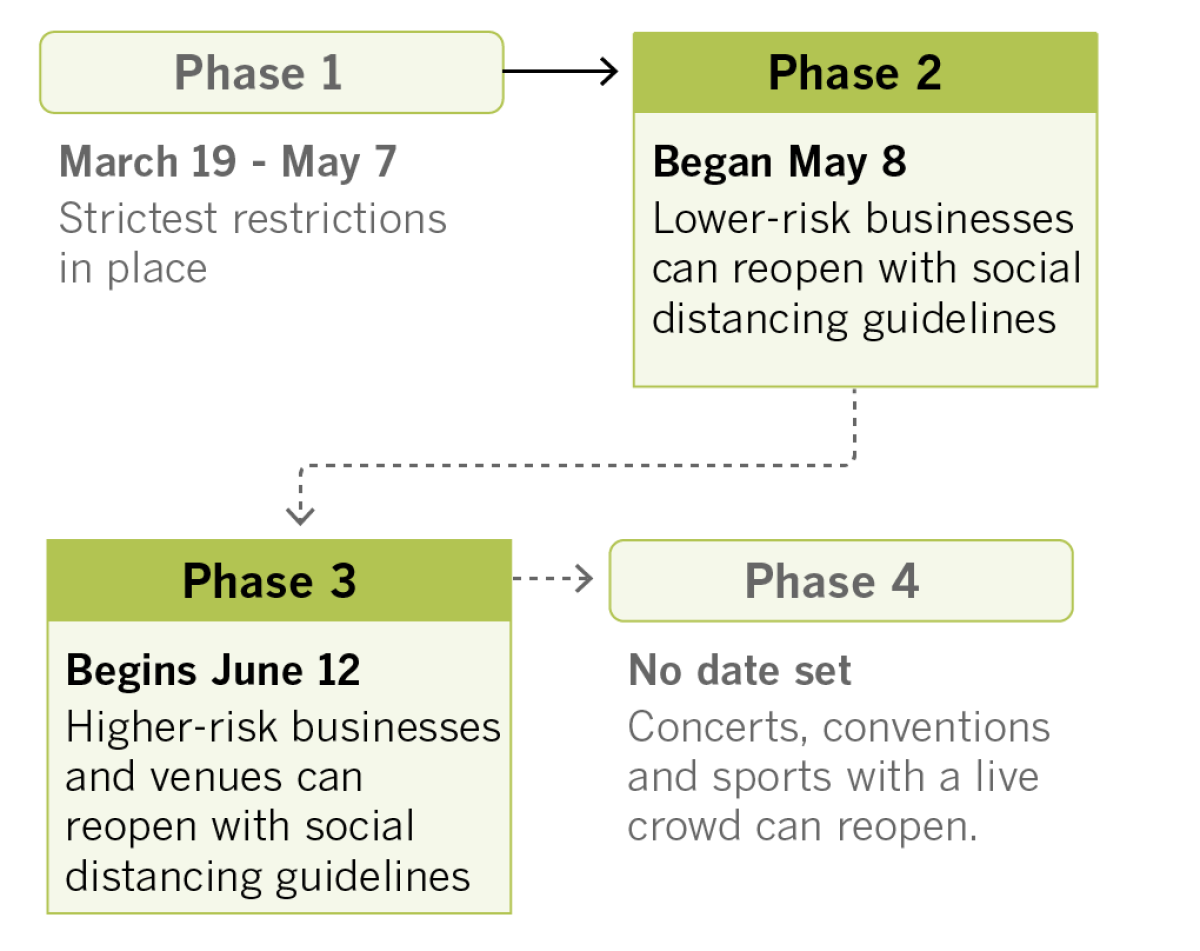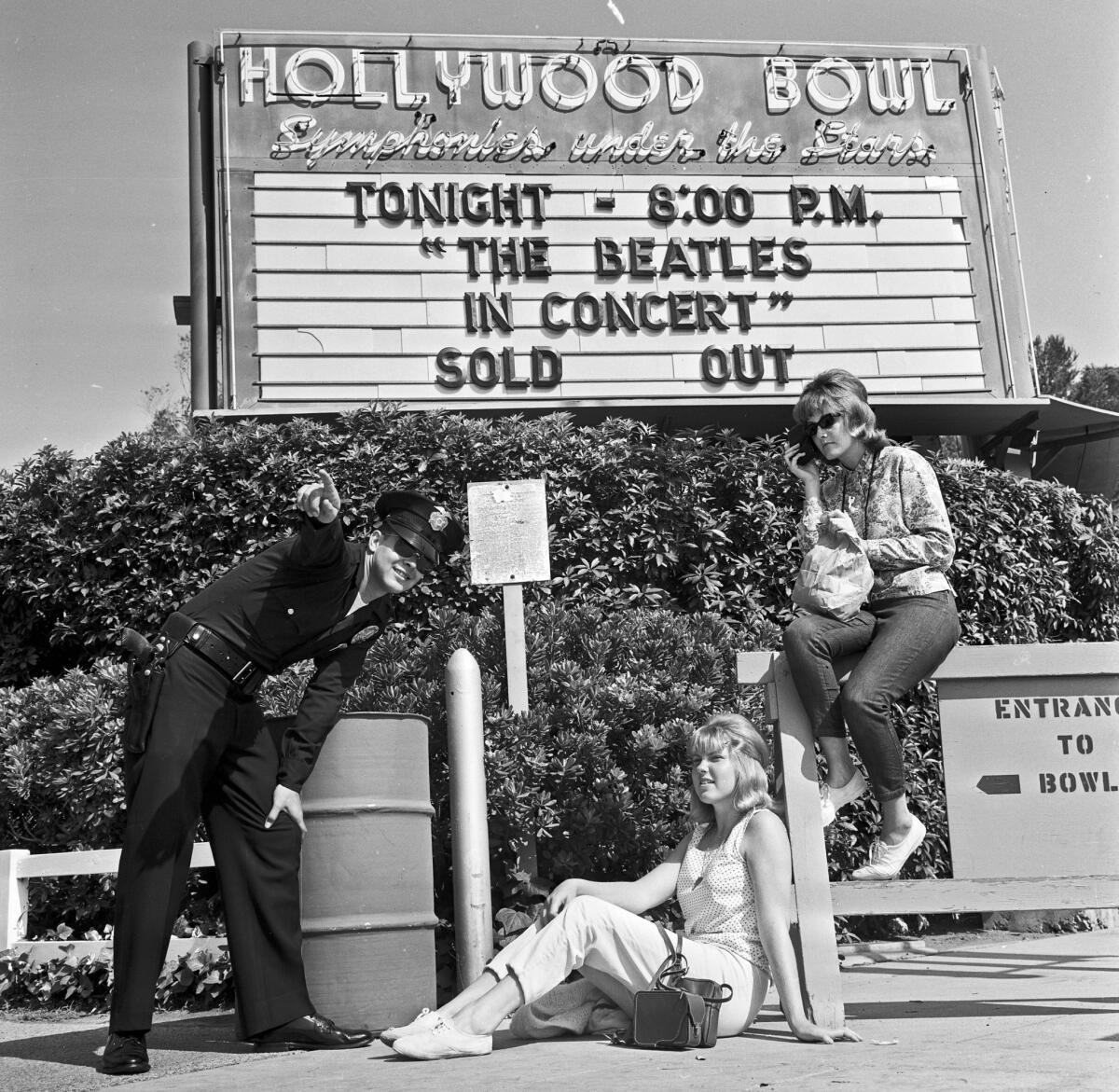Coronavirus Today: The question of reinfection
Good evening. Iâm Diya Chacko, and itâs Wednesday, May 13. Hereâs whatâs happening with the coronavirus in California and beyond.
Can you be reinfected with the novel coronavirus? Itâs a question scientists are still puzzling over thanks to stories like this: The first COVID-19 patient to be treated at Desert Valley Hospital in Victorville was discharged in early April after her apparent recovery, only to end up back in the hospital just a few weeks later. Sheâd tested positive for the virus for the second time.
Apart from the specter of reinfection, California is still struggling to control the mounting number of new coronavirus cases. Although the state hasnât seen anywhere near as many fatalities as New York, officials are concerned that the number of weekly COVID-19 deaths has hit a stubborn plateau, and the number of new cases has yet to begin a sustained week-over-week decline. In an effort to curb new cases, Los Angeles Mayor Eric Garcetti said Wednesday evening that everyone, except for small children and those with certain disabilities, must wear face coverings outside, significantly tightening earlier restrictions.
A UC San Francisco epidemiologist offered two reasons for the plateau: A certain percentage of Californians, such as essential workers, must go out, and others are getting fed up with staying home. He urged government officials to plan the reopening with the safety of essential workers in mind. âMake no mistake,â he said. âThe more the economy opens up, the more people are going to die. Make sure itâs not on the backs of all the poor people who are doing the front-line jobs who are going to get the most exposed.â
As states reopen their economies, workers who were given bonuses and raises to continue staffing grocery chains are beginning to see those benefits dry up. Itâs an unwelcome surprise to employees of Target, Walmart, CVS, Whole Foods, Costco, Sprouts and Kroger who feel the circumstances that won them extra pay havenât changed much. âThe pandemic isnât going away, coronavirus isnât going away, so why are they taking away these two dollars from us? Itâs absurd,â a Ralphs cashier said.
The pandemic is reversing years of growth in the clean energy industry, which has helped reduce air pollution and the greenhouse gas emissions responsible for climate change. The U.S. shed more than half a million clean energy jobs in March and April, and by far the biggest share was in California, according to an analysis of unemployment data. Most were energy-efficiency jobs involving installation of new lighting and appliances in peoplesâ homes â a scary prospect for those faced with the potential for viral transmission.
Still, policymakers see potential for investment in the sector to help get the economy back on track. âWe know the clean economy â transportation, housing, energy, water, manufacturing, waste, and natural and working lands â is one of the most cost-effective, resilient job creation sectors economy-wide,â a group of California lawmakers urged the governorâs office.
By the numbers
California cases and deaths as of 4:30 p.m. PDT Wednesday:
Track the latest numbers and how they break down in California with our graphics.

See which counties are reopening with our tracker.
Across California
Twelve of Californiaâs 58 counties â Amador, Butte, El Dorado, Lassen, Nevada, Placer, Plumas, Sierra, Tuolumne, Yuba, Sutter and Shasta â have met the stateâs conditions for more businesses to reopen, officials said Wednesday. Under the state plan, counties must have adequate testing and hospital capacity and the ability to trace those who have been in contact with ill people. The counties allowed to reopen are mostly rural; the rest of the state has yet to meet those criteria.
The number of Los Angeles businesses seemingly ignoring the mayorâs stay-at-home order has risen steadily as the shutdown drags on and many small-business owners struggle to stay afloat. Criminal misdemeanor charges have been filed against the owners of 60 businesses deemed nonessential, including a San Fernando Valley Harley-Davidson dealer, an Egyptian artifacts store and a dozen smoke shops. As punishment, they could lose their licenses to operate.
For the first time in its nearly 100 years, the Hollywood Bowl is canceling its entire season of film screenings and concerts. The Los Angeles Philharmonic Assn., which manages the venue, said Wednesday that it was impossible to attempt a summer season during the pandemic, which has caused mass furloughs and an $80-million budget shortfall for the organization.
âThe reality of a Hollywood Bowl gone quiet for the whole season,â writes arts reporter Jessica Gelt, âis hard to fathom when music played on during the end of one world war and throughout another, through Korea and Vietnam, though the Great Depression and the Great Recession, through 9/11 and all the floods, fires, riots and chaos in between.â

Hereâs some good news: On Saturday, the Angeles National Forest will reopen popular trails, roads and campgrounds that have been shut since April 4. Hikers and other outdoor users are asked to wear masks, stay 6 feet apart and follow guidelines from the Centers for Disease Control and Prevention. Campers and picnickers should limit gatherings to âa family that lives together, not to extended families to come together,â said a forest spokesman. Lands will be reopened for recreational use, not to encourage people to gather in large groups.
Resources
â For general safety, wash your hands for at least 20 seconds (hereâs a super-fun how-to video). Stop touching your face, and keep your phone clean. Practice social distancing, maintaining a six-foot radius of personal space in public. And wear a mask if you leave home for essential activities. Hereâs how to do it right.
â Watch for symptoms including fever, cough, shortness of breath, chills, repeated shaking with chills, muscle pain, headache, sore throat and loss of taste or smell. If youâre worried you might be infected, call your doctor or urgent care clinic before going.
â Hereâs how to care for someone with COVID-19, from monitoring their symptoms to preventing the virusâ spread.
â If your job has been affected by the coronavirus pandemic, hereâs how to file for unemployment.
â Here are some free resources for restaurant workers and entertainment industry professionals having trouble making ends meet.
â Advice for helping kids navigate pandemic life includes being honest about uncertainties, acknowledging their feelings and sticking to a routine. Hereâs guidance from the Centers for Disease Control and Prevention.
â In need of mental health services? Here are resources for coping during the crisis from the CDC and the L.A. County Department of Public Health. L.A. County residents can also call (800) 854-7771 or text âLAâ to 741741.
Around the nation and the world
The reemergence of the coronavirus in Wuhan, the first epicenter of the pandemic, has driven new lockdown orders and sparked fear among residents that another outbreak is on the horizon. âWe only just started going out for groceries again,â a woman said.
More than 100 people in Seoul have tested positive for the virus as part of an outbreak linked to a cluster tied to a popular nightlife district. The new cases unleashed a torrent of anger against the young revelers and ignited debates over personal responsibility and blame. And amid reports that the clubs visited by one COVID-19 patient were mostly gay clubs, the vitriol has raised concerns that the cityâs LGBTQ population could be vilified in a society where being gay is still largely taboo.
Staff and visitors to Canadaâs Calgary Zoo are bidding sad farewells to a pair of adult pandas on loan from China. Their sojourn in Calgary is being cut short three years ahead of schedule because the pandemic has disrupted their supply of fresh bamboo. âThis was an incredibly difficult decision to make, but the health and well-being of the animals we love and care for always comes first,â the zooâs president said.

Your questions answered
Todayâs question comes from Ann Cummings, who want to know: Do people see lasting health impacts from having had COVID-19?
Even though itâs been months since the coronavirus emerged, thereâs still a lot we donât know. Scientists are still struggling to pinpoint the longterm health impacts of COVID-19. âWhat we know has been gathered mostly by anecdotal reports from COVID-19 survivors,â said one infectious disease specialist at Emory University in Atlanta.
Reports from China suggest those with mild infections recover two to three weeks after first showing symptoms. But recovery may take much longer for those with the most severe infections, including patients who spent time on ventilators in hospital intensive care units. Wuhan doctors have reported heart problems in a small portion of hospitalized patients, including conditions like inflammation of the heart muscle and irregular heartbeats. The problems may have been caused by the virus itself, a hyperactive immune response to the virus, the treatment involved or a combination of all three, the Emory specialist said.
Some survivors who had long stays in intensive care may require oxygen therapy or dialysis at home. Some may develop a condition called post-intensive-care syndrome, which can include persistent muscle weakness, fatigue, attention and memory problems, and anxiety. The condition has been seen in COVID-19 survivors who were put on ventilators, but it can happen after any critical illness and may be related to treatment, including sedation and prolonged bed rest.
Ultimately, âthe short answer is that weâre still learning,â the specialist said.
Got a question? Our reporters covering the coronavirus outbreak want to hear from you. Email us your questions, and weâll do our best to answer them. You can find more answers in our Frequently Asked Questions roundup and in our morning briefing.
For the most up-to-date coronavirus coverage from The Times, visit our live updates page and our Health section, listen to our âCoronavirus in Californiaâ podcast and follow us on Twitter and on Instagram.





